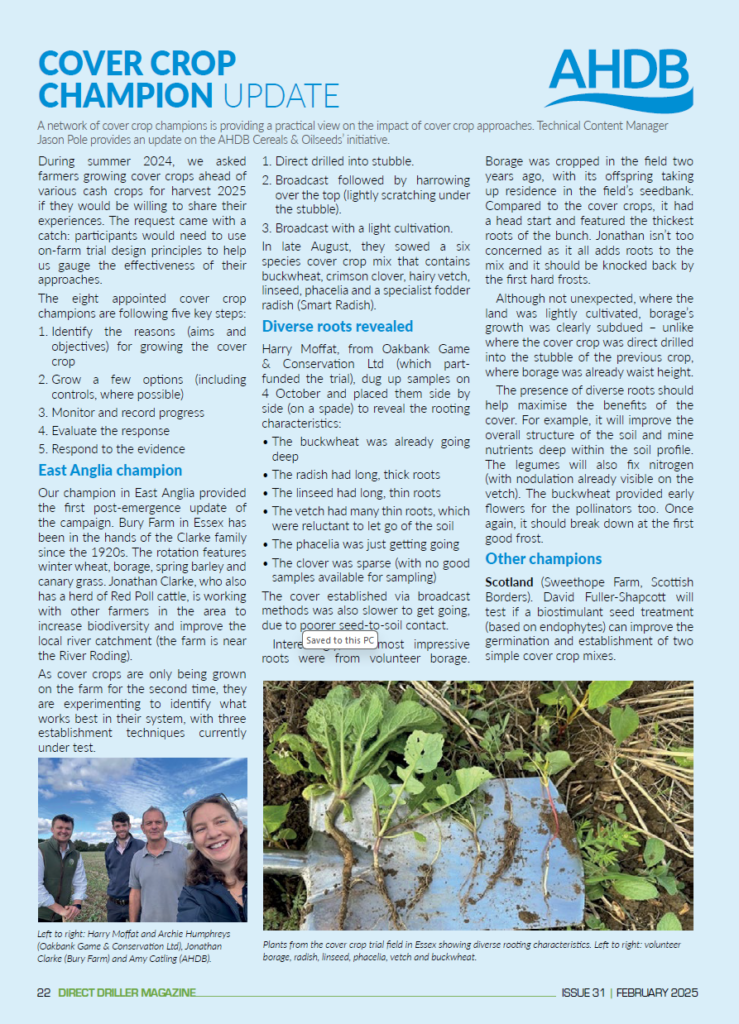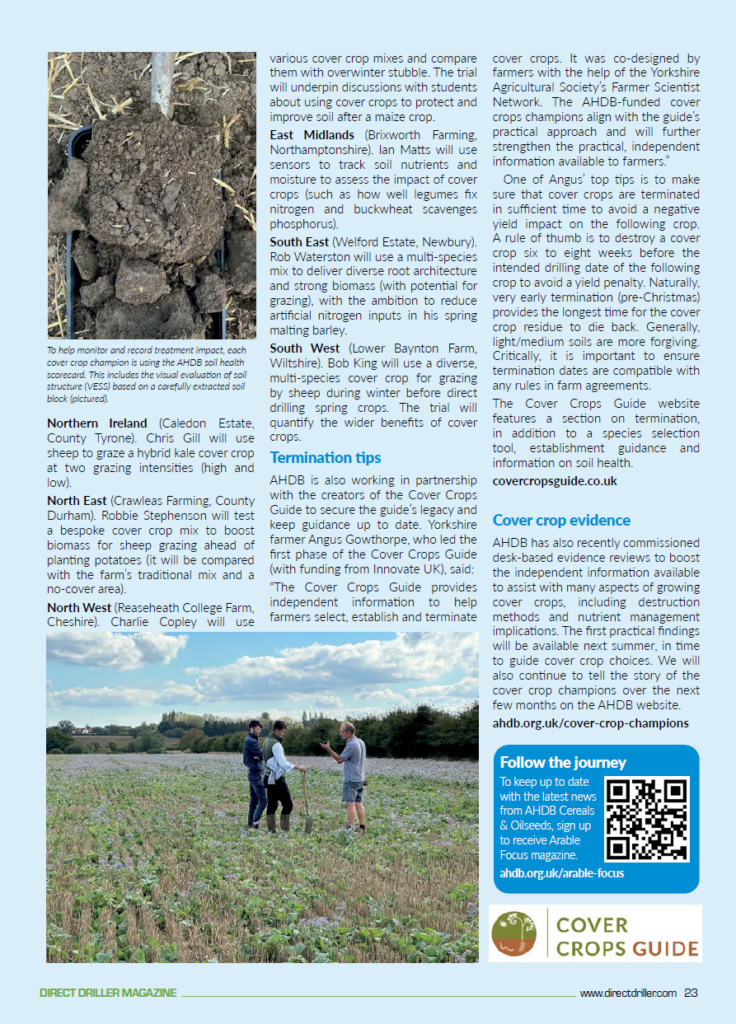A network of cover crop champions is providing a practical view on the impact of cover crop approaches. Technical Content Manager Jason Pole provides an update on the AHDB Cereals & Oilseeds’ initiative.
During summer 2024, we asked farmers growing cover crops ahead of various cash crops for harvest 2025 if they would be willing to share their experiences. The request came with a catch: participants would need to use on-farm trial design principles to help us gauge the effectiveness of their approaches.
The eight appointed cover crop champions are following five key steps:
- Identify the reasons (aims and objectives) for growing the cover crop
- Grow a few options (including controls, where possible)
- Monitor and record progress
- Evaluate the response
- Respond to the evidence
East Anglia champion
Our champion in East Anglia provided the first post-emergence update of the campaign. Bury Farm in Essex has been in the hands of the Clarke family since the 1920s. The rotation features winter wheat, borage, spring barley and canary grass. Jonathan Clarke, who also has a herd of Red Poll cattle, is working with other farmers in the area to increase biodiversity and improve the local river catchment (the farm is near the River Roding).
As cover crops are only being grown on the farm for the second time, they are experimenting to identify what works best in their system, with three establishment techniques currently under test.
- Direct drilled into stubble.
- Broadcast followed by harrowing over the top (lightly scratching under the stubble).
- Broadcast with a light cultivation.
In late August, they sowed a six species cover crop mix that contains buckwheat, crimson clover, hairy vetch, linseed, phacelia and a specialist fodder radish (Smart Radish).

Left to right: Harry Moffat and Archie Humphreys (Oakbank Game & Conservation Ltd), Jonathan Clarke (Bury Farm) and Amy Catling (AHDB).
Diverse roots revealed
Harry Moffat, from Oakbank Game & Conservation Ltd (which part-funded the trial), dug up samples on 4 October and placed them side by side (on a spade) to reveal the rooting characteristics:
- The buckwheat was already going deep
- The radish had long, thick roots
- The linseed had long, thin roots
- The vetch had many thin roots, which were reluctant to let go of the soil
- The phacelia was just getting going
- The clover was sparse (with no good samples available for sampling)
The cover established via broadcast methods was also slower to get going, due to poorer seed-to-soil contact.

Above: Plants from the cover crop trial field in Essex showing diverse rooting characteristics. Left to right: volunteer borage, radish, linseed, phacelia, vetch and buckwheat.
Interestingly, the most impressive roots were from volunteer borage. Borage was cropped in the field two years ago, with its offspring taking up residence in the field’s seedbank. Compared to the cover crops, it had a head start and featured the thickest roots of the bunch. Jonathan isn’t too concerned as it all adds roots to the mix and it should be knocked back by the first hard frosts.
Although not unexpected, where the land was lightly cultivated, borage’s growth was clearly subdued – unlike where the cover crop was direct drilled into the stubble of the previous crop, where borage was already waist height.
The presence of diverse roots should help maximise the benefits of the cover. For example, it will improve the overall structure of the soil and mine nutrients deep within the soil profile. The legumes will also fix nitrogen (with nodulation already visible on the vetch). The buckwheat provided early flowers for the pollinators too. Once again, it should break down at the first good frost.
Other champions
Scotland (Sweethope Farm, Scottish Borders). David Fuller-Shapcott will test if a biostimulant seed treatment (based on endophytes) can improve the germination and establishment of two simple cover crop mixes.
Northern Ireland (Caledon Estate, County Tyrone). Chris Gill will use sheep to graze a hybrid kale cover crop at two grazing intensities (high and low).
North East (Crawleas Farming, County Durham). Robbie Stephenson will test a bespoke cover crop mix to boost biomass for sheep grazing ahead of planting potatoes (it will be compared with the farm’s traditional mix and a no-cover area).
North West (Reaseheath College Farm, Cheshire). Charlie Copley will use various cover crop mixes and compare them with overwinter stubble. The trial will underpin discussions with students about using cover crops to protect and improve soil after a maize crop.
East Midlands (Brixworth Farming, Northamptonshire). Ian Matts will use sensors to track soil nutrients and moisture to assess the impact of cover crops (such as how well legumes fix nitrogen and buckwheat scavenges phosphorus).
South East (Welford Estate, Newbury). Rob Waterston will use a multi-species mix to deliver diverse root architecture and strong biomass (with potential for grazing), with the ambition to reduce artificial nitrogen inputs in his spring malting barley.
South West (Lower Baynton Farm, Wiltshire). Bob King will use a diverse, multi-species cover crop for grazing by sheep during winter before direct drilling spring crops. The trial will quantify the wider benefits of cover crops.
Termination tips
AHDB is also working in partnership with the creators of the Cover Crops Guide to secure the guide’s legacy and keep guidance up to date. Yorkshire farmer Angus Gowthorpe, who led the first phase of the Cover Crops Guide (with funding from Innovate UK), said:
“The Cover Crops Guide provides independent information to help farmers select, establish and terminate cover crops. It was co-designed by farmers with the help of the Yorkshire Agricultural Society’s Farmer Scientist Network. The AHDB-funded cover crops champions align with the guide’s practical approach and will further strengthen the practical, independent information available to farmers.”
One of Angus’ top tips is to make sure that cover crops are terminated in sufficient time to avoid a negative yield impact on the following crop. A rule of thumb is to destroy a cover crop six to eight weeks before the intended drilling date of the following crop to avoid a yield penalty. Naturally, very early termination (pre-Christmas) provides the longest time for the cover crop residue to die back. Generally, light/medium soils are more forgiving. Critically, it is important to ensure termination dates are compatible with any rules in farm agreements.
The Cover Crops Guide website features a section on termination, in addition to a species selection tool, establishment guidance and information on soil health.

Cover crop evidence
AHDB has also recently commissioned desk-based evidence reviews to boost the independent information available to assist with many aspects of growing cover crops, including destruction methods and nutrient management implications. The first practical findings will be available next summer, in time to guide cover crop choices. We will also continue to tell the story of the cover crop champions over the next few months on the AHDB website.
ahdb.org.uk/cover-crop-champions
Follow the journey
To keep up to date with the latest news from AHDB Cereals & Oilseeds, sign up to receive Arable Focus magazine.

Above: To help monitor and record treatment impact, each cover crop champion is using the AHDB soil health scorecard. This includes the visual evaluation of soil structure (VESS) based on a carefully extracted soil block (pictured).


